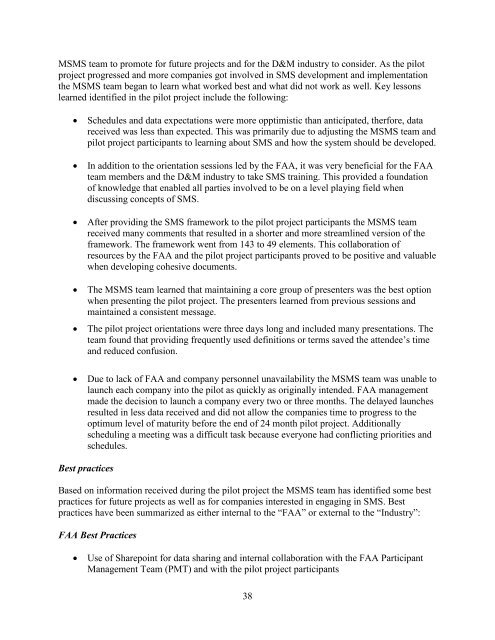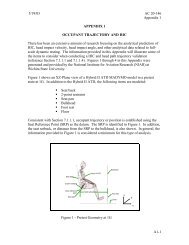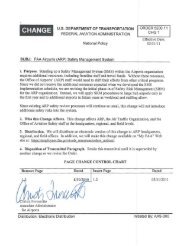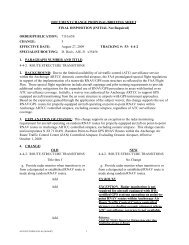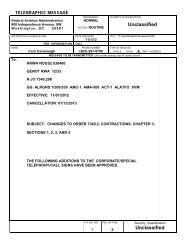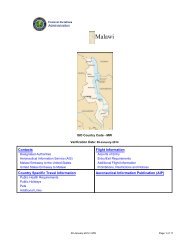2009 SMS Pilot Project (SMSPP) Analysis - FAA
2009 SMS Pilot Project (SMSPP) Analysis - FAA
2009 SMS Pilot Project (SMSPP) Analysis - FAA
Create successful ePaper yourself
Turn your PDF publications into a flip-book with our unique Google optimized e-Paper software.
M<strong>SMS</strong> team to promote for future projects and for the D&M industry to consider. As the pilot<br />
project progressed and more companies got involved in <strong>SMS</strong> development and implementation<br />
the M<strong>SMS</strong> team began to learn what worked best and what did not work as well. Key lessons<br />
learned identified in the pilot project include the following:<br />
• Schedules and data expectations were more opptimistic than anticipated, therfore, data<br />
received was less than expected. This was primarily due to adjusting the M<strong>SMS</strong> team and<br />
pilot project participants to learning about <strong>SMS</strong> and how the system should be developed.<br />
• In addition to the orientation sessions led by the <strong>FAA</strong>, it was very beneficial for the <strong>FAA</strong><br />
team members and the D&M industry to take <strong>SMS</strong> training. This provided a foundation<br />
of knowledge that enabled all parties involved to be on a level playing field when<br />
discussing concepts of <strong>SMS</strong>.<br />
• After providing the <strong>SMS</strong> framework to the pilot project participants the M<strong>SMS</strong> team<br />
received many comments that resulted in a shorter and more streamlined version of the<br />
framework. The framework went from 143 to 49 elements. This collaboration of<br />
resources by the <strong>FAA</strong> and the pilot project participants proved to be positive and valuable<br />
when developing cohesive documents.<br />
• The M<strong>SMS</strong> team learned that maintaining a core group of presenters was the best option<br />
when presenting the pilot project. The presenters learned from previous sessions and<br />
maintained a consistent message.<br />
• The pilot project orientations were three days long and included many presentations. The<br />
team found that providing frequently used definitions or terms saved the attendee’s time<br />
and reduced confusion.<br />
• Due to lack of <strong>FAA</strong> and company personnel unavailability the M<strong>SMS</strong> team was unable to<br />
launch each company into the pilot as quickly as originally intended. <strong>FAA</strong> management<br />
made the decision to launch a company every two or three months. The delayed launches<br />
resulted in less data received and did not allow the companies time to progress to the<br />
optimum level of maturity before the end of 24 month pilot project. Additionally<br />
scheduling a meeting was a difficult task because everyone had conflicting priorities and<br />
schedules.<br />
Best practices<br />
Based on information received during the pilot project the M<strong>SMS</strong> team has identified some best<br />
practices for future projects as well as for companies interested in engaging in <strong>SMS</strong>. Best<br />
practices have been summarized as either internal to the “<strong>FAA</strong>” or external to the “Industry”:<br />
<strong>FAA</strong> Best Practices<br />
• Use of Sharepoint for data sharing and internal collaboration with the <strong>FAA</strong> Participant<br />
Management Team (PMT) and with the pilot project participants<br />
38


